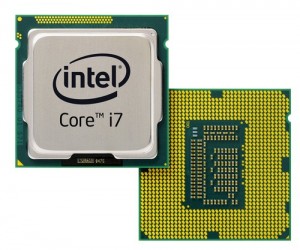 Intel yesterday announced its first third-generation Core processors code-named Ivy Bridge, which are faster and more power efficient than Core processors now used in laptops and desktops.
Intel yesterday announced its first third-generation Core processors code-named Ivy Bridge, which are faster and more power efficient than Core processors now used in laptops and desktops.
The initial Ivy Bridge lineup includes 13 quad-core processors for high-end desktops, laptops and all-in-one designs, said Kirk Skaugen, corporate vice president and general manager of Intel’s PC Client Group at an event in San Francisco that was webcast.
Intel will announce new Ivy Bridge chips for ultrabooks and mainstream laptops and desktops in the coming months, he said. The company has 570 PC designs — 270 desktop and all-in-one and 300 laptop designs — in addition to the 100 ultrabook designs for Ivy Bridge already in the works.
The ultrabook chips will be dual-core and low voltage, and small enough to fit into the thin designs of ultrabooks, which will be no thicker than 18 millimeters (0.7 inches). There have been “priority calls” in building Ivy Bridge ultrabook chips related to the thinner system designs, but the chip production is ramping up fast, Skaugen said.
Intel hopes future Ivy Bridge ultrabooks will blur the lines between laptops and tablets with touchscreens, long battery life, always-on connectivity, and gesture and voice recognition capabilities. Intel has said starting prices of ultrabooks will drop to US$699 by the end of the year.
Intel’s first Ivy Bridge chips include eight Core i7 processors, five Core i5 processors, and one unlocked Core i7-3920XM Extreme Edition processor, which Skaugen called the world’s fastest mobile processor. Acer announced new systems based on the quad-core Core i5 and i7 processors, with desktops priced from $699 and $1,199.
Most laptops and desktops today come with Core processors code-named Sandy Bridge, which were introduced early last year. The new Ivy Bridge chips provide up to twice the high-definition multimedia and 3D graphics performance and a 20 percent CPU improvement, Skaugen said. Acer has said that it measured Ivy Bridge processors providing a 20 percent CPU performance improvement compared to Sandy Bridge processors.
3D transistors are another major factor in performance improvements with Ivy Bridge chips. Those transistors improve application and graphics performance while preserving laptop battery life. Intel has said that 3D transistors — part of Intel’s new 22-nanometer manufacturing process — will consume a little less than half the power and be 37 percent faster than the company’s existing 32-nm process chips, which have 2D transistors. The 3D transistor technology replaces a flat, 2D transistor arrangement with a 3D structure that rises up from the silicon substrate.
There are also new security and graphics improvements with the new chips, which were not previously available. The new third-generation Core processors has on-chip support for DirectX 11, which will boost the graphics performance on Windows systems.
In the chip redesign, the company implemented a new graphics subsystem with twice the number of transistors that allowed it to boost graphics performance, Skaugen said. The new HD 4000 and HD 2500 graphics cores support input of up to three monitors at the same time.
The Thunderbolt interconnect will also start reaching PCs via motherboards supporting the Ivy Bridge platform. Thunderbolt, introduced over a year ago, is a high-speed connector technology to move data between computers and peripherals, and is mostly found on Apple’s Macintosh PCs. Thunderbolt laptops are expected to come later this year from PC makers like Lenovo, Acer and Asus.
Intel has also implemented the new QuickSync 2.0 on Ivy Bridge chips for quicker transcoding of specific video formats. The new technology can transcode video 23 times faster than a three-year-old PC, Skaugen said. The new Quick Sync technology is twice faster than the same technology introduced in last year’s Sandy Bridge Core microprocessors.
The company also introduced new features to keep PCs secure at the operating system level. OS Key and OS Guard features will provide hardware-level security to prevent malware attacks and will be available on PCs running Microsoft’s upcoming Windows 8 or Linux operating systems, Skaugen said. Intel has also implemented a new antitheft technology to lock down stolen PCs and the new version will be able to unlock systems via SMS.
There are some hardware-level improvements as well. Data will shuffle inside PCs a lot quicker, thanks to on-chip support from the new PCI-Express 3.0, the successor to the current PCI-Express 2.0 data transfer protocols. PCIe 3.0 can move data at 8 gigatransfers per second, which is faster than PCIe 2.0, which had a speed of 5 gigatransfers per second.





